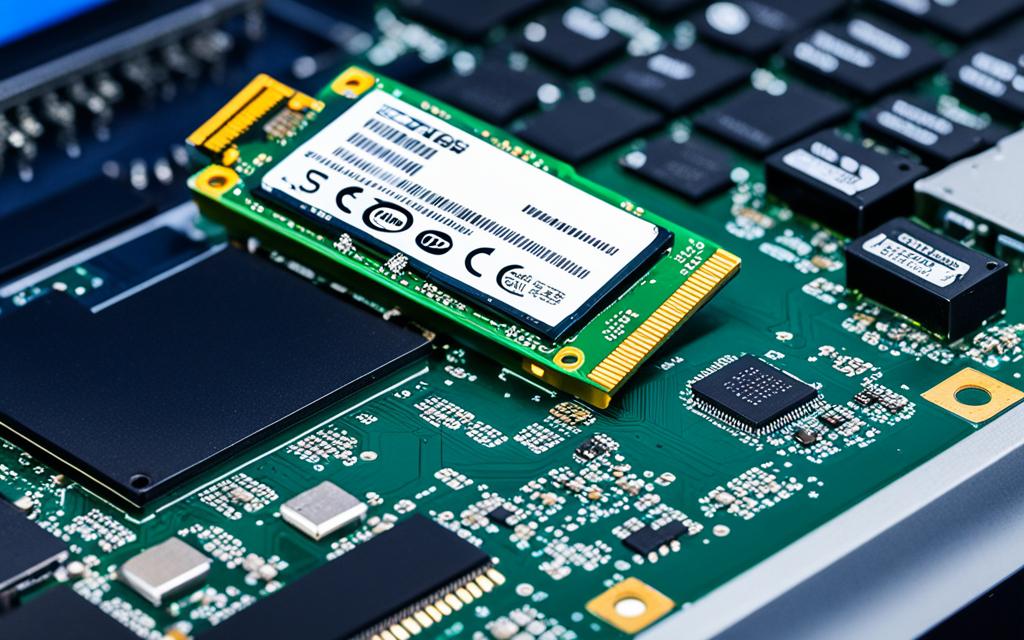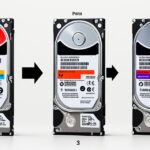Table of Contents
Formatting an M.2 SSD boosts system performance or changes the file system. It’s a key step for users on Windows 10. You can format your M.2 SSD in about 5 minutes using three easy methods. Choose from EaseUS Partition Master, Disk Management, or Command Prompt in the BIOS12. Each method is straightforward, suiting different needs and ensuring a smooth formatting process. We will look at why formatting is important, how to do it step by step, and things to keep in mind for success.
Key Takeaways
- Formatting an M.2 SSD can significantly improve SSD performance.
- There are multiple ways to format an M.2 SSD on Windows 10, each tailored to different user needs.
- EaseUS Partition Master offers an efficient way to change file systems quickly.
- Taking the time to format your SSD is essential before installing a new operating system.
- Back up your important data before proceeding with formatting to avoid any data loss.
The Importance of Formatting Your M.2 SSD
Formatting an M.2 SSD is crucial for it to work well and last long. Recognising the value of formatting importance is key to boosting SSD performance enhancement. By frequently formatting, the drive stays efficient and its quality remains.
Enhancing Performance
Formatting your SSD boosts its performance. Over time, unwanted files can slow it down. Clearing these files lets the SSD run smoothly. Using the TRIM command helps keep the SSD speedy after cleaning3. Around 80% of users format their new SSD before using it4. Knowing how to format quickly makes sure your SSD stays fast.
Changing File Systems
Formatting allows for changing the SSD’s file system. There are different file systems like NTFS, exFAT, and FAT32 for various purposes. For big files, exFAT is great because it doesn’t have a 4GB size limit like FAT325. NTFS is mostly chosen by Windows users for better compatibility5. This means you can pick the file system that fits your needs.
| File System | Maximum File Size | Common Uses |
|---|---|---|
| FAT32 | 4GB | Legacy devices and smaller file transfers |
| exFAT | No Limit | Compatible external drives, larger files |
| NTFS | No Limit | Windows installations, large-volume storage |
| APFS | No Limit | MacOS environments |
| Ext4 | No Limit | Linux systems |
So, knowing about formatting and file systems leads to better SSD use534.
How to Format M.2 SSD Windows 10
Formatting your M.2 SSD in Windows 10 is quite easy. It helps keep your drive running smoothly and improves how your system works. You can choose from three main ways to format: Use EaseUS Partition Master, Windows’ own Disk Management Tool, or the Command Prompt. Each method has its own benefits and things to consider for managing your SSD well.
Method 1: Using EaseUS Partition Master
EaseUS Partition Master makes formatting simple. Just right-click the SSD partition and pick the format option. You get to choose the file system and cluster size then hit “OK”. This software is a favourite because it’s easy and streamlines formatting M.2 SSDs.
Method 2: Disk Management Tool
To use the Disk Management Tool for formatting is another handy method. Just right-click the Windows Start button and select “Disk Management.” Then, find your SSD and choose to format it with the right file system from a list. This easy step will ensure your SSD is set up properly.
Method 3: Command Prompt / BIOS
The Command Prompt is a helpful choice for SSDs that don’t respond. You need to start from Windows installation media and use commands to format. Key commands include ‘diskpart’, ‘list disk’, and ‘clean’. This method lets you control the formatting directly, making it fit your needs.
| Method | Steps Involved | Ease of Use | Primary Functionality |
|---|---|---|---|
| EaseUS Partition Master | Right-click to format and select options | High | File system and cluster size selection |
| Disk Management Tool | Access through Start menu and format | Moderate | File system selection through a menu |
| Command Prompt / BIOS | Execute commands in boot media | Advanced | Direct command formatting |
Choosing the best way to format can greatly affect your SSD’s performance. Whether you prefer the easy-to-use EaseUS Partition Master or the detailed approach of the Command Prompt, knowing your formatting methods will make things smoother367.
Additional Considerations Before Formatting
Before you start formatting your M.2 SSD, think about several things to make sure your device is ready and optimised. This will help your device work better.
Back Up Important Data
Backing up your SSD data is a must. It’s important to keep your files and apps safe. Formatting might erase them forever. Use external drives or cloud services for backup. This keeps your important stuff safe during formatting. Not backing up can result in losing crucial data, which is a big risk.
Choosing Between Quick and Full Format
You need to decide between a quick format and a full one. A quick format removes files but doesn’t delete them until overwritten. This means you could get your data back if needed. On the other hand, a full format erases everything for good. It increases security but takes more time. Think about your need for quick access vs. data security before deciding.
| Format Type | Data Recoverability | Security Level | Time Required |
|---|---|---|---|
| Quick Format | Recoverable if not overwritten | Low | Seconds to minutes |
| Full Format | Not Recoverable | High | Hours |
If you want to know more about formatting NVMe SSDs, check out the detailed guidelines and precautions.
Post-Formatting Steps for Optimisation
After you format an M.2 SSD, it’s important to optimise it. This ensures it works well and lasts long. You need to follow specific steps for this.
Run TRIM for SSD Health
The TRIM command is key for keeping your SSD in top shape. It helps the drive manage space better, which boosts its performance over time. By running the TRIM command, you’ll see faster write speeds. This makes your SSD work better overall. To do this, use the “Defragment and Optimise Drives” utility in the Windows search menu11.
Monitor SSD Health
Keeping an eye on your SSD’s health is vital. Regular checks with the right software can warn you about problems like overheating or wear. Tools like Seagate’s SeaTools offer maintenance checks. These checks increase your drive’s lifespan and safeguard your data12. Paying attention to health signs helps you manage your SSD well and keep it performing as it should.
Conclusion
Formatting your M.2 SSD correctly in Windows 10 is key for the best performance and storage use. There are easy methods for SSD formatting. This means you can choose the best way for you, depending on what you know and need. You might use Disk Management, EaseUS Partition Master, or command line options.
It’s vital to back up your data regularly and use TRIM technology after formatting. Doing this not only makes your Windows 10 run better but also helps your SSD last longer. An SSD can keep your data safe for over ten years. By understanding the difference between quick and full formatting, you can make better choices for your drive.
Learning how to format unlocks your M.2 SSD’s true power, making your computer faster and more dependable. Moving to an SSD can greatly improve how quickly your applications run. If you need more help with installing and managing SSDs, there’s a detailed guide here13144.
FAQ
Why should I format my M.2 SSD?
Formatting your M.2 SSD enhances performance and supports file system changes. It clears temporary files, boosts read/write speeds, and offers a fresh start.
What are the different methods to format an M.2 SSD in Windows 10?
There are three methods to format an M.2 SSD in Windows 10. You can use EaseUS Partition Master, the Disk Management tool, or Command Prompt via BIOS. Each suits various user needs and technical levels.
What is the significance of backing up data before formatting?
It’s crucial to back up data before formatting to avoid losing important files. This secures your files, apps, and system settings, keeping them safe during formatting.
What’s the difference between Quick Format and Full Format?
A Quick Format removes files but leaves the data, which allows for later recovery. Full Format writes zeros to the drive, making data recovery tough. This trade-off between speed and security is important to consider.
How can I optimise my M.2 SSD after formatting?
Optimise your M.2 SSD by running the TRIM command to efficiently manage data blocks. Regularly check SSD health with specific software to maintain performance and extend its life.
What file systems can I choose from when formatting my SSD?
You can choose NTFS, FAT32, or exFAT when formatting your SSD. Each system has benefits, like better device compatibility or support for big files.
Can I format an M.2 SSD if it is not responding?
Yes, format an unresponsive M.2 SSD by booting from Windows installation media. Use Command Prompt for formatting commands to fix access issues with the drive.
Is regular maintenance needed for my M.2 SSD?
Absolutely! Keep your M.2 SSD in top shape with regular maintenance. This includes health checks and optimisation commands to prolong its life and peak performance.
Source Links
- https://www.easeus.com/partition-manager-software/how-to-format-m-2-ssd-in-windows-10.html – How to Format M.2 SSD in Windows 10 [Detailed Instruction]
- https://www.seagate.com/blog/how-to-install-an-nvme-ssd/ – How to Install & Format your M.2 NVMe SSD | Seagate US
- https://www.crucial.com/articles/about-ssd/how-to-format-a-solid-state-drive – How to Format a Solid State Drive (SSD)
- https://www.easeus.com/partition-master/format-new-ssd.html – How to Format New SSD in Windows 10/11 [100% Working Solutions]
- https://www.kingston.com/en/blog/personal-storage/how-to-format-ssd – How to Format Your SSD
- https://www.diskpart.com/format-disk/how-to-format-m-2-ssd-0725.html – How to Format M.2 SSD on Desktop & Laptop?
- https://www.wikihow.com/Format-an-M2-Ssd – How to Format an M.2 SSD Drive on Your PC or Mac
- https://forums.tomshardware.com/threads/how-to-format-a-drive-without-losing-data.3688874/ – Question – How to format a drive without losing data.
- https://www.stellarinfo.com/blog/format-nvme-ssd-on-windows/ – How to Format an M.2 NVMe SSD on Windows? | Stellar
- https://learn.microsoft.com/en-us/windows-server/storage/disk-management/initialize-new-disks – Initialize new disks
- https://www.diskpart.com/articles/format-nvme-for-windows-10-install-0001.html – How to Format NVMe for Windows 10 Install Safely and Easily
- https://www.partitionwizard.com/partitionmagic/how-to-format-ssd.html – 3 Different Ways to Free Format SSD with No Harm to SSD – MiniTool Partition Wizard
- https://www.diskpart.com/articles/format-nvme-drive-windows-10-0725.html – How to Format NVMe Drive in Windows 10?
- https://recoverit.wondershare.com/format-harddrive/format-ssd-windows-10.html – How to Format an SSD on Windows 10?








